18 March 2016
There is a mythological world nourished by Ophelias in pre-Raphaelite style and reassuring Molly Ringwalds, brochures of unspoiled landscapes and intimate songs by the Smiths. It is the pseudo-real world of Ryan McGinley (1977), who earned himself a place amongst the elite of international photography with The Kids Are Alright (1999), a self-published book that led to him being given a solo exhibition at the Whitney Museum of American Art (2003), and then at the MoMA PS1 (2004), both in New York. Now his dreamlike and undisciplined imagery, peopled with long-limbed bodies and orgiastic expressions, has arrived at the GAMeC in Bergamo with an exhibition curated by Stefano Raimondi that brings ten years of his excursions together around the theme of the four seasons. In this long interview conducted face to face in his New York studio, McGinley retraces his career from the beginnings and offers a glimpse behind the scenes of Winter, the most ambitious of the series in this photographic exploit.
On January 15, 2007 I remember buying the New York magazine and finding your picture on the cover: you were lying on an unmade bed between your friends, also artists, Dan Colen and Dash Snow. Under the title “Warhol’s children,” the cover maintained that you were doing your “outrageous best to prove that downtown [New York] lives on.” What’s your relationship with the city that never sleeps?
When people ask me where I am from I say I am from Downtown NY, like that’s it. Always between 14th Street and Canal Street. I lived in the East Village, hung out in the Lower East Side. They are pretty much the same thing, they are just separated by one street. I have been hanging out there since the early Nineties.
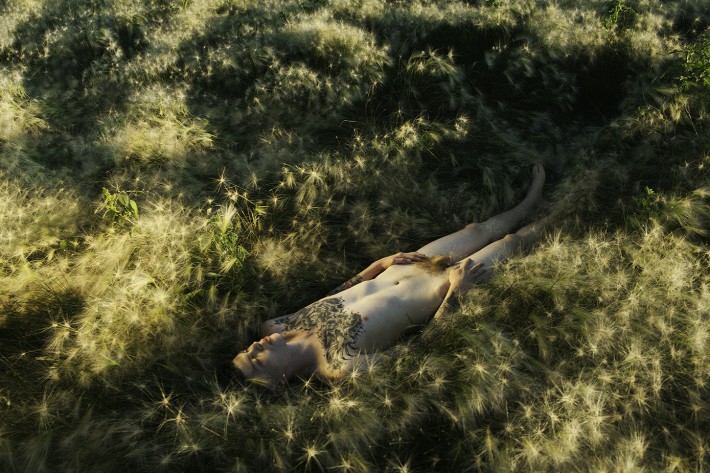
Ryan McGinley, Shane (Foxtail Barley), 2014.
You were born in New Jersey. What prompted you to go there at an early age?
I am the youngest of eight brothers, one of them was a gay guy. He, his boyfriend and their friends used to live in NYC. Then from a very young age I used to come and spend time with them. So that was the connection and it was in my DNA, the bridge between New Jersey and NYC. From my house where I grew up till here it only takes 45 minutes. Right after school we would take a train and start out skateboarding by the Brooklyn Bridge. Then once 6 pm hit and all the people were leaving their jobs from Midtown, we would go there to skateboard. We were close to the MoMA, where I’d go with the school once or twice a year, from 1st to 8th grade. I used to visit institutions like the Metropolitan, the Guggenheim or the Natural History Museum, so when I started to go on my own that was part of what I did.
When did you finally move to NYC?
When I was 18, but by then I was already part of a community. Twenty years later and more I see people in the streets that I knew when I was 13. I met this guy recently—he is older than me ,maybe 50—and he said: “did you use to go dancing at this club called N.A.S.A.?” I said: “yes, how do you know that?” And then he goes: “I remember you.” And this is just some guy who I met randomly through a friend. When I asked who he was he told me his name was DB and he used to throw parties: he was the big DJ. Besides, there are a lot of people from New Jersey I still meet around. My nickname back then was Ginch, which came out of McGinley somehow. And so when people call me that I close my eyes and think “Oh Jersey,” then turn around and it’s someone I know from back in the days.
You then went to Parsons School of Design, next to Union Square, right?
Yes, I went to study painting but at the end of the first year I realized I didn’t want to do that. Then I switched to poetry in my second year, and I was really into the history of NY and the Beat poets, Allen Ginsberg and William S. Burroughs, that whole scene. By the end of that year my parents had found out that I switched my major without telling them and they told me they wouldn’t help me to pay my rent if I didn’t switch out of poetry. So I went for graphic design, ’cause it seemed to me I could learn about computers and get a professional job.
How did you step into photography from there?
Graphic design is typography and images. I started to take photos for my projects and then once I got a camera it was like: “this is so cool.”
Looking through your visual recordings that go back a long time, it seems natural to think you became a photographer at a very young age.
You know, when I was skateboarding I was always the person who filmed everybody. I was the kid with the camera. I was documenting the community. Trying to make a video, which is pretty similar to what I do now.
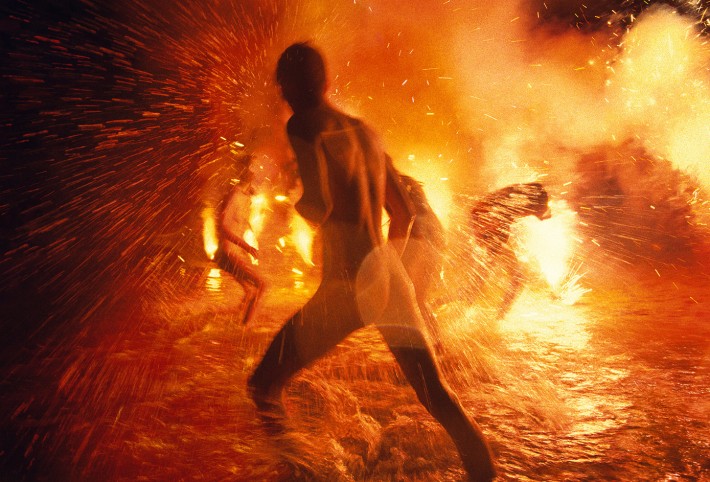
Ryan McGinley, Wet Blaze, 2013.
Were you obsessive with the camera?
I am an obsessive person in general. Right now I am trying not to be codependent in a relationship! When it gets to the art, I am obsessed with small movements: I don’t want the big picture, but I want to know everything, even the tiniest detail, about that. Also with music: when I discover a new genre I can contradict myself. I was always the person who, when asked which music I was into, would say “everything except for country.” And in the last year it’s been all about country. Someone was playing it in the car and it was fucking great. So now I am in the country music bubble and instead of being a normal person, listening to some Dolly Parton and Johnny Cash, I have to go through everything. When I got the camera, I wanted to learn every different way: documentary, architecture, studio photography. So I did it, shooting a lot.
Do you listen to music while shooting?
I do, always. Even before iPods I always had a boom box with me and a little soundtrack for shooting. It sets the tone, sets the mood. Puts the people at ease, puts me at ease. Like when you are watching a movie and there is a good scene with a great song that just makes it cinematic.
As well as being an integral part of you work method, is music a source of inspiration too?
When I was a kid my whole room was covered with concert posters, not one square inch free. I remember once going to a photographer’s home and seeing she had blowups of all of her photos, big-size photographs. And I just couldn’t believe that she blew all her photos up that big: I knew the people in the photos, and somehow it elevated them to the same level as my concert posters. I thought “she is making her own posters, this is amazing!” and wanted to figure out how to do that too. That really blew my mind early on.
You also embraced music as a field of interest and spent years shooting people during concerts. The result is a series of close-up portraits gathered under the title Grid for a monographic show held at Team Gallery in 2012. What got you so into it?
This is a series from 2007 to 2011, I went to all the big music festivals around the world, and shot people watching music, mainly kids being hypnotized by their favorite bands. It all started when Morrissey (former leader of The Smiths) agreed to let me photograph his concerts in the years 2004-06. I started developing a relationship with his dedicated friends. A concert is a place where people release, you can cry, dance insanely: all that you can’t do in the world you can do there. The concert would start and all of the photographers had their cameras pointed at the musician on the stage, and I turned the other way to focus on the fans who were highly emotional while the music played. Some of those fans looked like figures in a Renaissance painting.
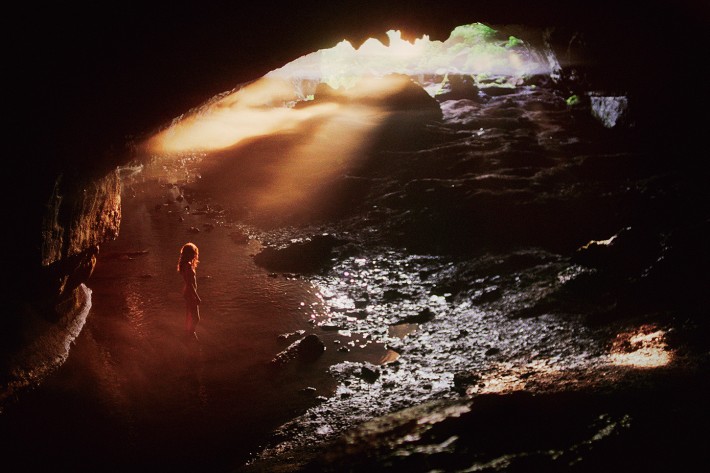
Ryan McGinley, Mouth Creek, 2014.
You seem to be a sponge in every field of creation. I wonder, what have you absorbed from the photographic tradition?
I saw Sally Mann’s series Immediate Family before I even started taking photos. It was floating around and somehow it was the first photobook that made it into popular culture for me. Another book I really liked back then was Theater of Manners (1997) by Tina Barney, shot in houses in places like the Hamptons. Self-portraits of her and pictures of her friend’s kids. This life reminded me of John Hughes’ films, like Sixteen Candles (1984) or Pretty in Pink (1986): films that I really liked about a life I wished I could have. A wealthy upper-class life, with Laura Ashley design and flower curtains: nice homes but not too fancy. It was Barney’s aesthetics and I still don’t know why I wanted badly to look at that book, yet I was always picking it up. It felt dreamy. I would also go through many magazines like Dazed and Confused, iD, Dutch.
This comes as a surprise. Your early work has been strongly associated to an intimate community-driven documentary photography, which emerged mostly in the nineties and depicted countercultures. I am thinking of the Boston School (Nan Goldin, Mark Morrisroe, Jack Pierson, etc.), Larry Clark or Wolfgang Tillmans. How do you feel about that?
Indeed my early work has a connection with them. I feel NY has five-year waves: every five years someone comes to NY and experiences the city, has a group of friends who are out every single night partying and discovering how to become an artist, and there is usually a photographer in that community, right? I consider my first five years of taking photos to be in that lineage, like 1998 to 2003.
Until your first monographic show at the Whitney Museum of American Art in New York?
Yes, that was kind of the divide. After that show I was such a young artist and I realized I wanted to get out of NY. Up until then I was figuring out my style, what I liked, shooting my scene, the circle of artists that were part of my life. But I was also broke and didn’t have the possibility to do anything bigger than what I was doing. The Whitney brought new opportunities and opened doors, and I was ready to take on bigger projects. So I started doing road trips.
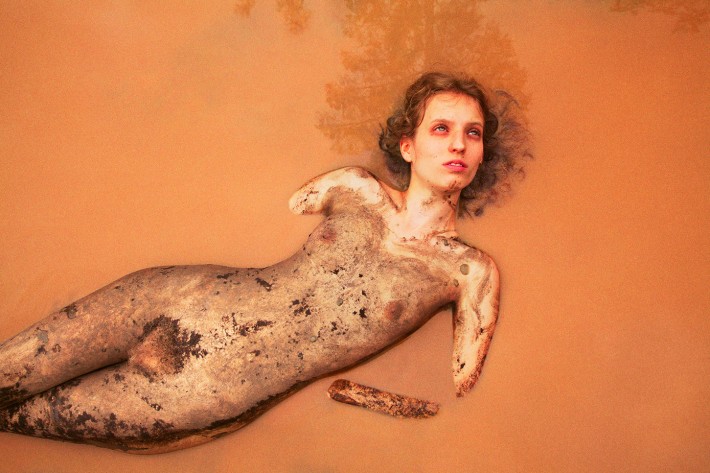
Ryan McGinley, Petra (Pieces), 2013.
Who gave you this opportunity?
When I was working on the show I met the fashion designer Agnes B., who started to collect my work from the beginning. She is very sweet, like a mother figure: she would fly me and a bunch of artist friends to Paris and just take care of us, buying my work and Dan Colen’s too. I developed a friendship with her and after the show I had this idea: I had never traveled the US, had lived in New Jersey all my life, never took a plane before, coming from a family where we never had the money to do anything. And then NY became my world. I had Robert Frank’s The Americans (1958) in my mind, Richard Avedon’s The American West (1985), the movie Easy Rider (1969) with Dennis Hopper. Through skateboarding, every skateboard video I would watch was about skaters touring the USA and going on these trips. I wanted to see the rest of the country where I grew up.
And what was the deal with Agnes B.?
So I told her I wanted to go away for three months, bring my friends with me, and the photos would have looked like those that I made back then, a lot of nature, nudity, different landscapes, the vibe of the road trip. I tried to calculate how much it would cost to pay the people that I was photographing. In return I would give her work that I had done. She accepted: asked for my bank account and wired me the money. She totally helped me out.
With the road trips the aesthetics of your work change completely: the lights, the colors, and the background of course, from the traditional urban setting to an immersion in breathtaking natural landscape. Was it a huge transition from the point of view of the photographer too?
It was pretty much the polar opposite. I never thought about it. I guess after five years in NY I was ready for that change.
In both works there is something extreme, a taste for living that escalates to where it almost becomes the counterpoint. Almost. There is never that dark side we are used to when an artist portrays a community built on vision, creativity and excesses. I would say the common thread is rather a chasing after freedom. Is that right?
I had gone through so much suffering by that point. My brother and a handful of his friends who raised me died within three years of AIDS, from 1993 to 1995. I wanted my world to be about celebration and about living. The opposite of what I witnessed, from somebody like my brother who had all the freedom in the world and was full of energy. His boyfriend was a Barbra Streisand impersonator. He did the Wicked Witch of the West in The Wonderful Wizard of Oz. All this life down to nothing, skin and bones.
Has this explicit attitude toward the content of your work driven you to take a more staged approach to photography?
Well the first five years I was a fly on the wall. Still I wouldn’t consider myself a documentary photographer, like Bruce Davidson. I wasn’t in the Magnum tradition of photography. Also when I started taking photos it was right at the beginning of the internet, so people sort of knew where photos ended up. The people that I was photographing were from the Downtown art scene where people were aware of being in an image, more than they had been with the photography of the past. I would maybe consider myself a pseudo-documentary photographer: close, but something else.
How did you come up with the idea of relating your work to seasons?
I had never shot in fall or winter before. I traveled every summer for a decade and that’s how I paved the way for most of my work: 2014 was my tenth summer, then I decided to move forward.
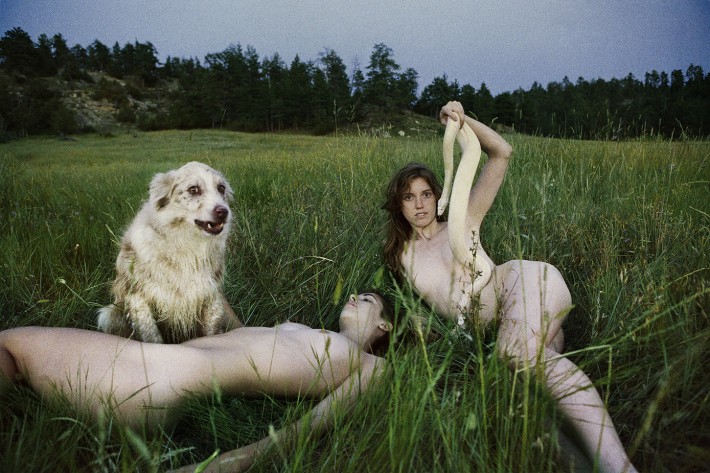
Ryan McGinley, Jessica and Anne Marie, 2012.
Were you roaming around or did you have a plan?
I had a plan, it was dictated by landscape. There was a lot of stuff in the south, like cypress trees, deserts and sand dunes in the west, massive rain forests between Oregon and around North Dakota, Death Valley. Sometimes we would spend three months in just one place, staying in campgrounds or motels. I had a tour bus. Have you ever seen the movie Twister (1996)?
I haven’t, I’m afraid. But you make me think of music again: I can picture you on tour!
Well you know the bus for car rentals that picks you up at the airport? Maybe 20 people can fit into it. I tailored it to be able to sleep in it and made shelves to store the photo equipment. It had a refrigerator for snacks and around 12-13 people could sit in it.
But then you wanted to try something new, right?
Yes. What I am interested in is doing things that haven’t been done in photography before: I did the cave series with nudes, and felt like I had never seen photos like that. It was new. I do a lot of research for my work: watch movies, go through catalogues of people rock climbing, look at reportage of war in the New York Times, look at people in and out of saunas. I want to shoot photographs in my style with amazing landscapes and dynamics in it. And make them look real, even though last winter in the US was the coldest winter in history.
Was it different from when Kathy Ryan, photo editor of the New York Times Magazine, commissioned you to shoot the Winter Olympics of 2010?
At the time I shot skiers, ice skaters, snowboarders, people that flipped in the air. The whole scene. It showed me that it was possible to shoot all day long in the cold. I learned how to manage the camera so as to acclimatize to the weather, to save the batteries, and do it quicker. It was a good learning experience, and I used a lot of that knowledge when working on the Winter series.
What did you have to do to make these pictures look real?
As on any such expedition, you first have to get people the right warm clothes. The next step is figuring out how to get to a place, since most of the time you have to hike a few miles. A big thing is safety, and most of the times in winter roads are closed and if you use Google it takes you somewhere else. I had to go on my own to the locations first, or send a scout to figure out how to get there. Then you have to bring a tent with you, something that doesn’t weigh 40 pounds like the one I had. It will hurt your back. I bought a light tent that can fit around 4 people in it. Last but not least I had to bring a sled to carry all the materials—photo equipment, food, propane tanks (they last 2 hours each), heater—and I ended up looking like a Sherpa!
How did you prepare the models?
I created a sauna for them by heating the tent. Actually, I realized that you cannot bring just one or two models, you need more because in the cold someone can only last 2 minutes per shot. You want to cycle people so they have time to recover and warm up while you are into the next shot. For me, I don’t want to have too much down time while shooting, it’s cold for me too! Still I didn’t renounce the music: we had music nonstop.
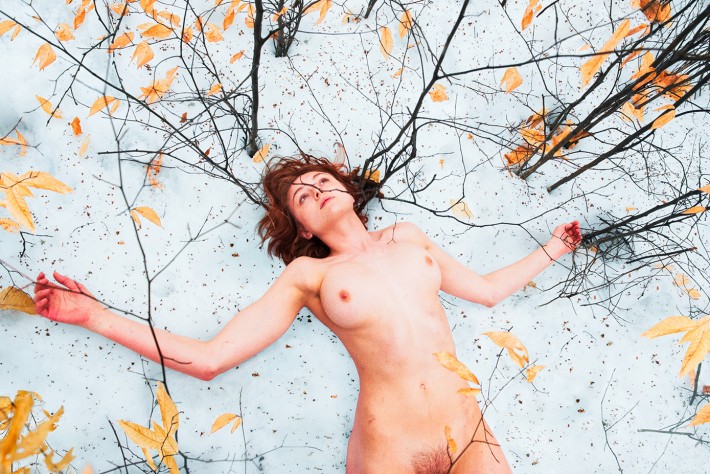
Ryan McGinley, Minnewaska, 2015.
You have quite a reputation for being a photographer who shoots all the time. Did you have to reconsider your methodology for this new project?
Well yes, and I could only stay two days with a group of people because after that it gets tough on your body. The cold drains your energy and you get tired very quickly.
What’s the behind-the-scenes of the shooting?
When I shoot there is usually lot of people around. I feel very comfortable like that because I come from a big family, and then I don’t have to say anything: the chemistry of everybody else just happens. I have a videographer, camera assistants, a producer who makes sure everyone has snacks, is safe; and he keeps me on track too. It’s pretty similar to an independent film crew. Actually I have a hit girl too, who takes care of the choreography, gets people into acting, deejays and sets the tone or makes the playlist to bring people up, to have a quite intimate moment, to mellow. She is next to me so people look at her and into the camera eye.
What happens when the performance is over?
It’s just me, a vacuum in the office, all alone and surrounded by images.
Your photos embody the potential of storytelling. Whenever I look at a picture of yours with someone sitting on the back of a pickup, diving into a mysterious lake, floating in the air or running in the middle of a wheat field, I can’t help but ask myself where do they go or come from, or what motivated that. How do you obtain this immersive experience from the perspective of the viewer when editing?
I try to cover as much as possible of what people are doing. It’s almost like I am filming, but with a camera. However, when I am back I immediately knock out fifty percent of the material that I know will not work. Shooting for some years I learned to find the right moment pretty quickly. And then I print the photos out Xerox paper size: I really don’t like editing on a computer, it’s very hard for me. I love touching the pictures, being able to compare them with other stuff and shuffling them in my hands. Same as how you look at a book.
How would you describe that moment?
Authentic, real. When you look at it you don’t have to think that it is contrived. Even if you know obviously that a nude in the ice is not authentic, I want the viewer not to even think about it, to be absorbed and seduced by the landscape, the light and the color. It has to feel like reportage, an image you see in the newspapers: you are not thinking about a photographer telling the model what to do. The model has to be lost in the moment. There is such a fine line… That’s what makes photography good: whatever genre, still life, fashion or documentary, the author needs to appear absent. The performance the person is giving has to be real, because it actually is real: the model is caught in an adventure, lost in the landscape, and even though I am setting everything, I am still documenting his own experience.
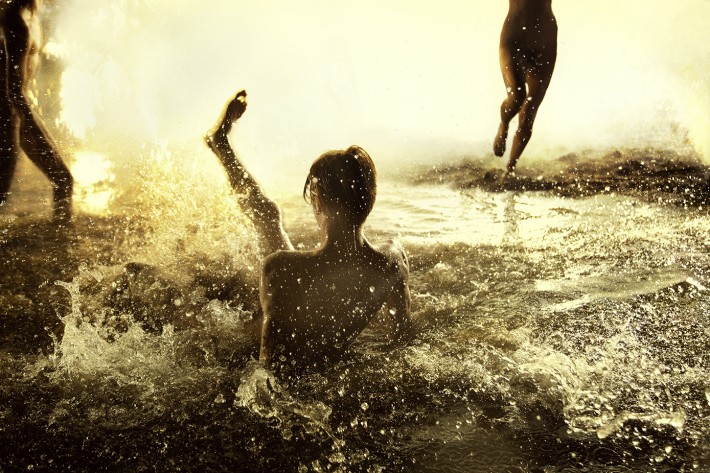
Ryan McGinley, Flash Flood (Gold), 2012.
Have you experienced anything similar with the other seasons?
The spring and summer go hand in hand since I have been always shooting in these seasons. The fall is new to me just like the winter. I have literally traveled across the country to find a specific page and color. A clay river feels electric; the color is what drives me here or there. I was not searching for clichés: people are used to calendars, Facebook notifications about the most beautiful fall photograph, paths through cultures. It was a challenge to shoot the season and not make it feel cheesy.
Those photos are often highly manipulated too and look fake. Do you ever use Photoshop?
When I shot film I didn’t need it. Film is great because you don’t have to do much to it, when it comes out, it’s just great. I stopped shooting film in 2010, and when you get a digital picture back it’s just shit. Everything is smooth, there is no graduation, it’s more flat but in its own world. You can still see the potential, it’s a starting point. So I bring it back and first thing I do I add it to Photoshop and add grain, soak up everything. I had to scan the negative to get the right grain layers not to get the image too crisp or pristine. What is good for landscape doesn’t work for a body or the fur of a dog. You learn by doing that you have to blur certain things and add four layers of grain. I have become very nerdy and technical to make photos look like film.
This sounds demanding. Why can’t you go back to film instead?
Because I would go bankrupt, literally. In my studio in 2010 we had a coup, just like when they try to overthrow the government. They asked me to stop shooting film. “You have to stop because you don’t have money to make trips and pay people a salary.” I was really against it, but my producer didn’t give a shit: he bought me a digital camera and asked me to use it for two weeks on a trip to Pennsylvania. It was impressive: I was finally able to blow up photos to wall size, and budget-wise I was not stressed anymore about taking photos! When I started to work as a photographer you know that every picture, every time you click the shutter, is like 10 cents. To develop is like a quarter. It’s seems silly, but back then I was broke.
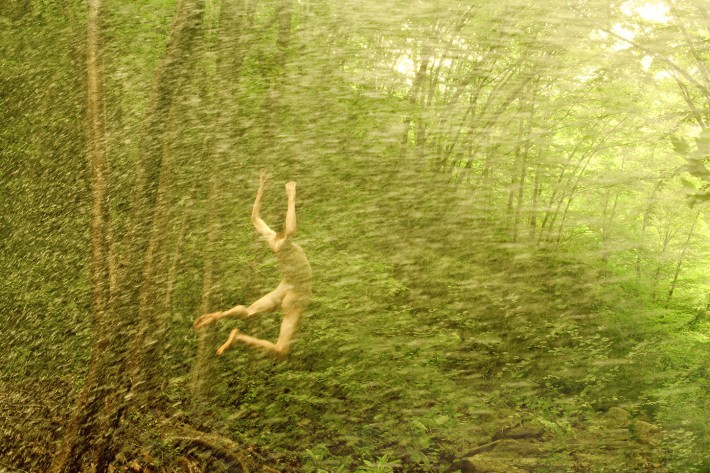
Ryan McGinley, Alex (Hurricane), 2010.
Take a dive into the past. Given the price ratio, how much would you use the camera?
From 1998 to 2003 I would go out with fifteen rolls of film every night: I would put five rolls in my front pocket, five in the other, and sometimes I had film in my socks. I had my whole process: I would buy expired film from photo stores for a dollar per roll and at the end of every week I would have a hundred rolls of film. To select the best shots, I used to make contact sheets in the darkroom, one roll for each piece of photographic paper. The shop would ask two dollars to develop the entire film but I had to cut the paper myself. Things got more extreme when I started doing my trips across America. I’d shoot 3000 rolls every summer. A lot… It’s such freedom not to use film anymore. Besides I am a vegetarian and it’s reassuring to think about the processing that is not happening anymore.
Painting would have been less expensive! Why did you actually quit painting, if I may ask?
I didn’t want to be in a studio. I feel like photography gets me around and in places I would not expect to be. Something comes out of that and forces me to interact with the world.
Photography is a medium that deals more with the real. You can be a painter and live inside your head all the time, right?
And I feel living inside my head is very comfortable to me, but my head is a dangerous place. Photography is 50-50. For me it works perfect because I can communicate with people with a camera in front of my face all the time. It’s like I am photographing you and we are having a communication, but we are really not, because I have this black box over my face most of the time. I feel like it helps me. Naturally I enjoy isolation, and this is what I like about editing. Photography brings me out into the world but it’s comfortable because I can still hide behind a camera. And with a group of people the chemistry always unfolds. Then I can come back, go into isolation and have time for myself to create my world.
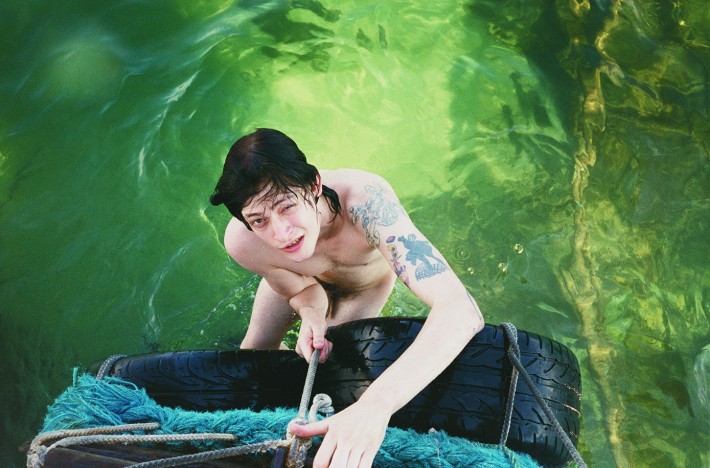
Ryan McGinley, Jake (Cannes), 2005.
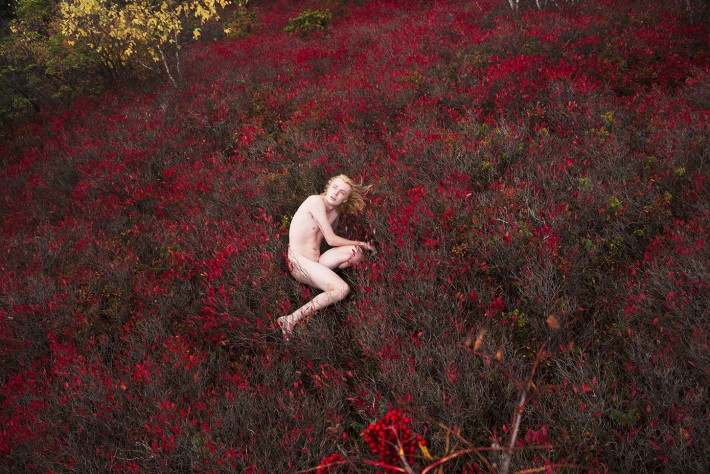
Ryan McGinley, Jacob (Red Blueberry), 2015.

Ryan McGinley, Red Maple Bust, 2015.
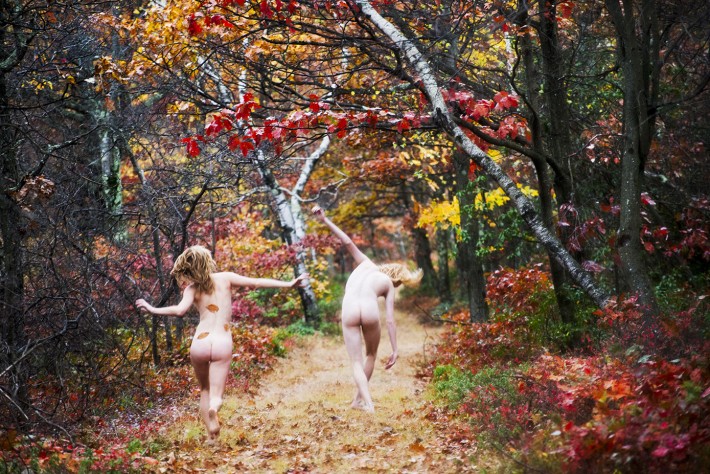
Ryan McGinley, Peepers, 2015.
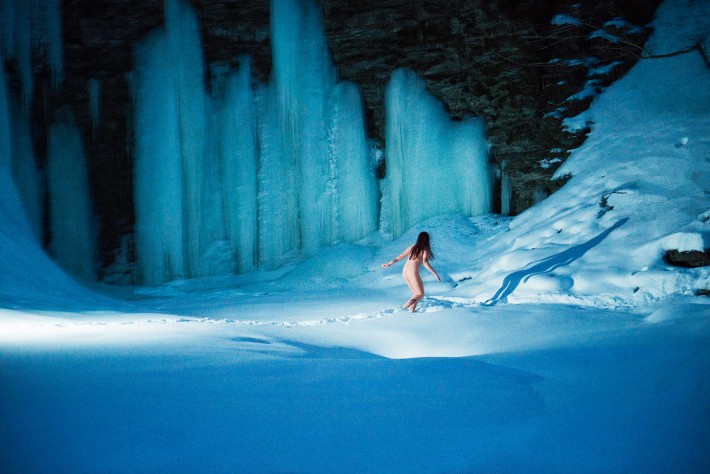
Ryan McGinley, Eagle’s Cliff, 2015.

Ryan McGinley, Judds Cherry, 2015.
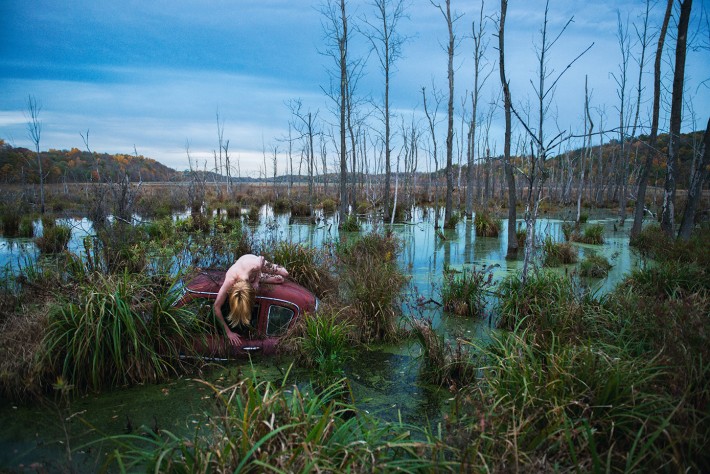
Ryan McGinley, Red Beetle, 2015.
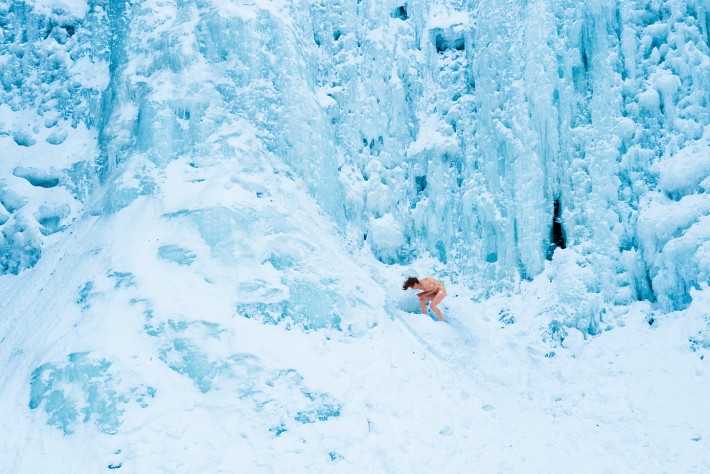
Ryan McGinley, Plotter Kill Storm, 2015.
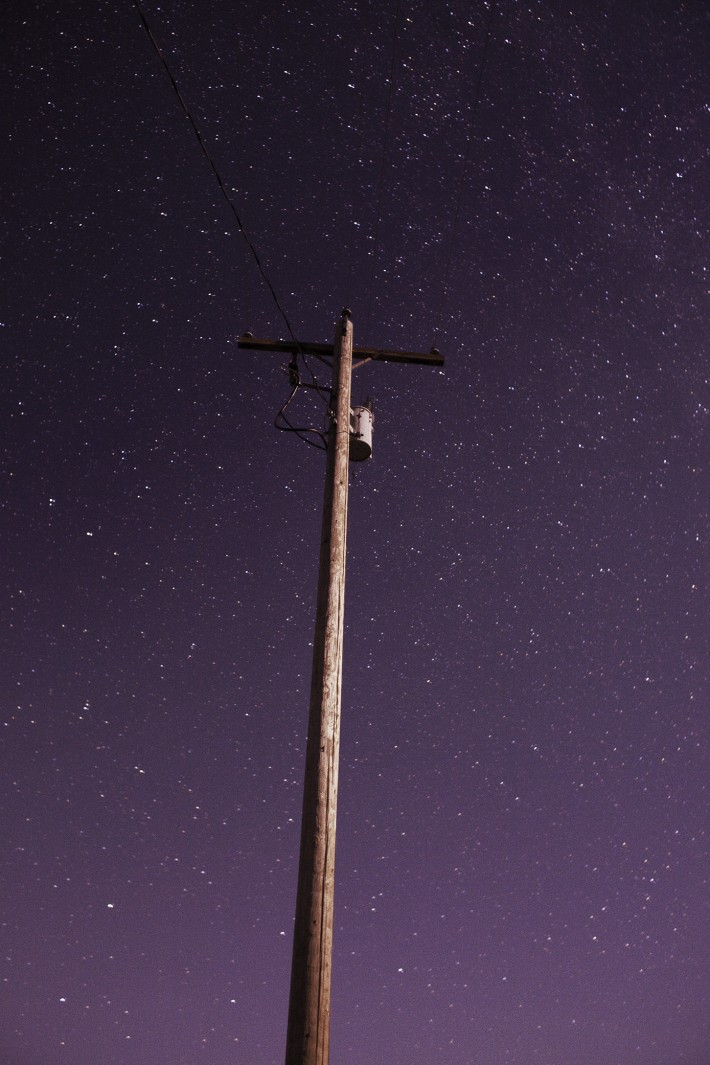
Ryan McGinley, Night Sky (telephone pole), 2014.